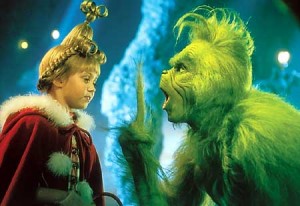Every holiday season, dozens of writers attempt to trivialize the holiday season through popular culture. Chestnuts like It’s a Wonderful Life, Miracle on 34th Street and A Christmas Story are stretched in order to say greater things about our society – statements like the spirit of giving in the face of economic adversity or the deep strain of melancholy that bubbles under everyone’s holiday season, regardless of how many friends and family members one has to rally round.
No such messages can be shoehorned into the bloated, live-action adaptation of Dr. Seuss’ How the Grinch Stole Christmas, released unto an unsuspecting public ten Christmas seasons ago. But its twisted, restructured narrative and garish design not only makes it a prime exhibit of how not to celebrate the season on film, but also makes it an excellent flop to rediscover in the discount bins of your local supermarket.
 Theodor Giesel’s original tale of The Grinch is simple yet engaging: the perpetually grumpy antagonist attempts to rob the citizens of Whoville of their Christmas presents and decorations, but when they joyously celebrate without all the trimmings, they teach The Grinch the true meaning of the season and he happily, heartily joins them. While it’s completely effective, it is, like most Seuss books, short. The famed 1966 television adaptation, brilliantly animated by Chuck Jones (who turned the character from black and white to green and gave him an iconic voice in Boris Karloff), ran for 25 minutes. Naturally, a feature-length version requires padding; the live-action Grinch, clocking in at 101 minutes, may as well be wearing a fat suit.
Theodor Giesel’s original tale of The Grinch is simple yet engaging: the perpetually grumpy antagonist attempts to rob the citizens of Whoville of their Christmas presents and decorations, but when they joyously celebrate without all the trimmings, they teach The Grinch the true meaning of the season and he happily, heartily joins them. While it’s completely effective, it is, like most Seuss books, short. The famed 1966 television adaptation, brilliantly animated by Chuck Jones (who turned the character from black and white to green and gave him an iconic voice in Boris Karloff), ran for 25 minutes. Naturally, a feature-length version requires padding; the live-action Grinch, clocking in at 101 minutes, may as well be wearing a fat suit.
”The Grinch hated Christmas, the whole Christmas season,” film narrator Anthony Hopkins intones early on in the film. ”Now, don’t ask why, no one quite knows the reason.” Of course, fans of the book and TV special know exactly why – his heart is two sizes too small – but have you ever wondered what shrunk his heart? Of course you don’t, but that didn’t stop Jeffrey Price and Peter Seaman (writers of the excellent Who Framed Roger Rabbit and the miserable Wild Wild West) from coming up with a reason. And what a doozy! An extended flashback shows a young Grinch enduring a cruel round of bullying at Christmas time. This comes after a half-hour of miserable materialism in Whoville – all the garishly made-up townfolk, clad in foolish latex noses and wacky wigs, are obsessed with buying the best presents and laying out the best decorations. So self-absorbed are they that you want The Grinch to steal Christmas – which he does, after nearly an hour of junk that doesn’t happen in the movie.
This film would probably be hard to watch regardless of who’s in it, thanks to that miserable script and plodding direction by Ron Howard. But it’s made particularly unbearable by its leads. Jim Carrey, buried under fur and latex, barely looks like The Grinch, much less himself. His off-the-wall shtick has its moments – his detailed Grinchy schedule is one of the few genuinely hilarious bits in the film (“5:00 – solve world hunger, tell no one”) – but it’s largely just another batch of funny voices and faces for a guy who’d already been doing funny voices and faces for a long, long time.
 More absurd, however, is young Cindy Lou Who, played by the nightmarish Taylor Momsen. At the time, Momsen was a six-year-old child actress with few chops past a cloying streak more powerful than eight Olsen twins. But her dippy performance is even more disturbing knowing that the now-16-year-old is not only a fixture on the trashy Gossip Girl but the needlessly raunchy leader of a Hole-lite band called The Pretty Reckless, in which she wears ripped fishnets and pounds of eye makeup. One also wonders how so many television veterans – Christine Baranski, Jeffrey Tambor and Molly Shannon – all got sucked into the mess as second-dimension adult Whos.
More absurd, however, is young Cindy Lou Who, played by the nightmarish Taylor Momsen. At the time, Momsen was a six-year-old child actress with few chops past a cloying streak more powerful than eight Olsen twins. But her dippy performance is even more disturbing knowing that the now-16-year-old is not only a fixture on the trashy Gossip Girl but the needlessly raunchy leader of a Hole-lite band called The Pretty Reckless, in which she wears ripped fishnets and pounds of eye makeup. One also wonders how so many television veterans – Christine Baranski, Jeffrey Tambor and Molly Shannon – all got sucked into the mess as second-dimension adult Whos.
Most irritating, however, is how a simple, powerful story was taken from the page and drained of any meaning on film. Nothing could stop the original Whoville’s Christmas cheer, either in the book or on the small screen, but this version won’t even let them start without a goofy set piece or half-hearted power ballad. Only with 15 minutes left in the movie does the true meaning of Christmas buzz through anyone’s head – and by that point, who cares? We’ve learned more about the season from the movie where Joe Pesci’s head gets set on fire. That’s what makes the 21st century Grinch so disreputable – even more so than the arguably worse adaptation of The Cat in the Hat from 2003, which starred Mike Myers and a cache of fart jokes. That book was simply an exercise in reading, not a tale with a moral to ruin.
The Christmas season is all about giving, and being thankful for those gifts even when they’re not what you want. But a silly sweater or gift certificate to Red Lobster won’t bastardize the very meaning of the season like this one. For that, those who made The Grinch into a yammering mess deserve a fresh batch of coal to go with the unhealthy sums of revenue that came with it.





Comments